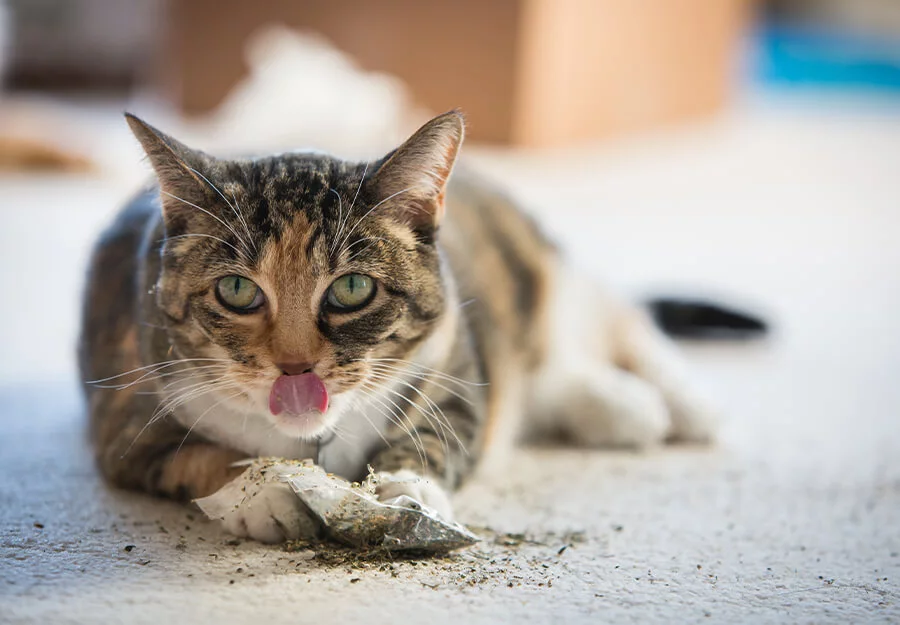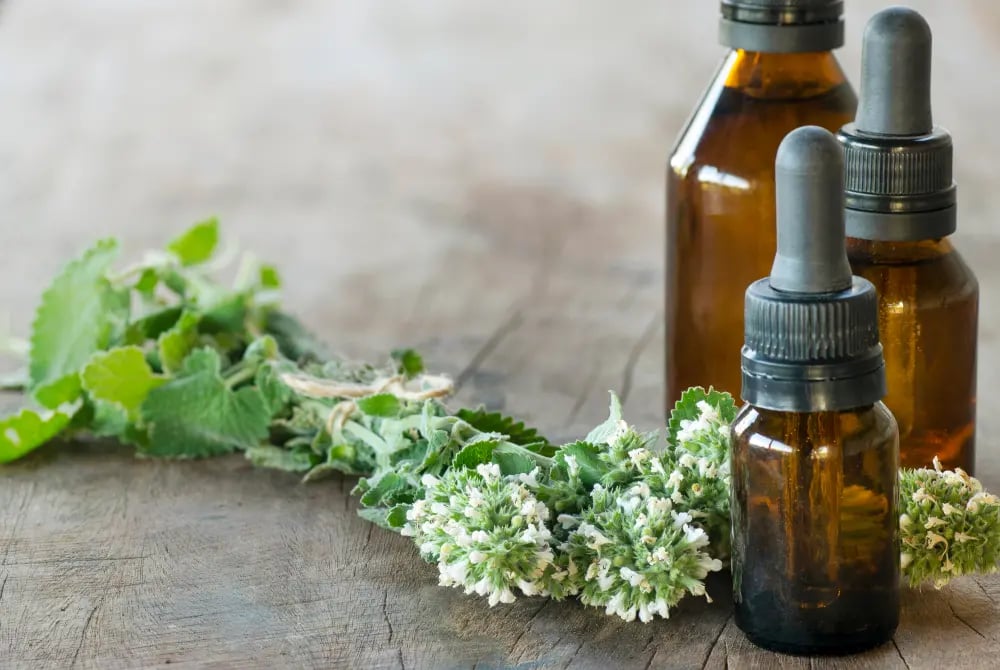
We, humans, have a list of vices longer than our arms, but your cat has just one– and it’s actually not harmful at all. Enter, catnip, the plant that turns your Garfield-lazy cat into a swiping, biting, crazed kitten, who can’t seem to stay still. So, how exactly does this plant work?
CATNIP OIL - A Guide
As strange as your cat’s behavior may become, you can feel safe about letting your cat indulge in this vice – why not give her a little pinch of the stuff right now, and let her bounce off the walls while you educate yourself on what it is and why it causes such a powerful effect on your furry feline friend.
What Is Catnip?
Native to Europe, Asia, and Africa, catnip (Nepeta Cataria: cats wort, cats mint) is a member of the mint family and grows as a loosely branching perennial with fragrant pink or white flowers. Widely considered a weed in North America, as it’s hardy and spreads easily, and is also commonly used as an ornamental garden plant--finally, this plant is easy to grow.
The volatile oil nepetalactone (a feline attractant) is found inside the stems and leaves of the plant and is believed to mimic a feline pheromone which plays into a cat's enjoyment for a short-lived time.
Not only are domestic cats affected by this plant, but large-breed cats respond, too. Cougars, lynxes, leopards – even lions and tigers have a reaction.
What Does Catnip Do to Cats?

The plant itself binds to a cat’s olfactory receptors, which are responsible for sensing chemicals called pheromones. Cats can have varying responses to the plant, depending on how they are exposed.
Typically if this plant is ingested, it acts as a sedative, and if it’s inhaled a stimulant.
Inhalation Effects:
- Excitement and hyperactivity
- Anxiety Leaping around Rolling on the ground
- Rubbing against the plant or dried leaves
- Pawing at it Licking at it
Catnip Ingestion Effects:
- Aggression (biting and growling)
- Euphoria
- Sleepiness
- Drooling
- Purring
- Meowing
After exposure, these effects can last anywhere from 5 to 15 minutes which is then followed by a refractory period (about 2-3 hours) in which your cat will not be affected by catnip.
Sounds like your cat has a substance problem, doesn’t it?
NOTE: Do not use it on pregnant cats, as it’s a uterine stimulant and could cause premature labour.
Why Do Cats Like Catnip?
Pheromones are powerful and drastically affect the behaviour of living organisms. Because catnip triggers an attractant pheromone in cats, they can’t help but react in a strong way.
Reaction to this plant is believed to be an inherited trait, as about 50-75% of cats are affected by this treatment, while somewhere around 20-30% are not.
Kittens and senior cats don’t usually react to catnip. Some believe they don’t respond because of their underdeveloped or weakened sense of smell. Others believe it’s because kittens and senior cats have no or little sexual activity, making them immune to nepetalactone and the feline pheromones connected to it.
Is Catnip Good for Cats?
This plant carries with it a host of benefits for your beloved feline friend. These effects can vary from stimulant to sedative, so whatever Fifi is feeling, you can give her a little pick-me-up.
From exciting her and getting her up and bouncing around to soothing her nerves and improving her mood, this is indeed a safe and fun treat to give to your cat.
Catnip Reduces:
- Stress
- Anxiety
- Depression
Catnip Encourages:
- Energy
- Euphoria
- Excitement
Catnip is not harmful, but moderation is a good idea. A common side effect of over-consumption is vomiting or diarrhea, but more than likely, your cat will usually lose interest in it before this happens.
Different Forms of Catnip

- There are many ways to give this treat to your feline friend:
- Loose - A few pinches will go a long way.
- Spray - Spray on her toys and anytime she needs some extra excitement.
- Bubbles & Catnip Essential Oil - Either buy the bubbles or make your own with essential oil. Fun not only for your cat but for you, too!
- Toys - With no mess but all the fun of regular catnip.
- Scratchers - These scratchers have the plant included for extra enjoyment.
- Cookies - Try your hand at some homemade treats.
Catnip FAQ
How much can my cat have?
A few pinches of dried product per exposure is enough. It’s potent stuff, and your cat only needs a small amount to become stimulated. If you grow catnip in the house, keep just one plant in your cat’s area to limit her exposure.
Is catnip safe for cats?
Yes, catnip is completely safe for cats. While it’s technically possible for a cat to overdose on it, causing vomiting/diarrhea as mentioned above, your cat will recover, and this isn’t a big concern.
Is catnip safe for dogs?
Yes, this plant is safe for dogs. While it doesn’t cause them to go berserk, catnip is actually quite useful for dogs, too. You can use it on your dog as a: Mild sedative, Diuretic Gastrointestinal remedy (upset stomach), Natural antiseptic
Note: Do not give catnip to pregnant dogs, as it can trigger uterine contractions.
How do I grow catnip?
This plant grows to be 3’ – 5’ tall and blooms from autumn to late spring. You can harvest the leaves throughout the year.
Grows best in:
- Full sunlight
- Well-watered, light, sandy soil
Be sure to promote the proper growth of your plant with regular deadheading.
Preparing leaves:
- Dry out the leaves in your oven at a very low setting OR Hang them to dry in a well-ventilated area.
Catnip will crumble easily when it’s ready. Be sure to store it in an airtight container and keep it out of direct sunlight.
Where can I buy catnip?
You can buy it from nearly any pet supply store. If you prefer shopping online, here is our selection of catnip and toys with the plant.
Does catnip have any effect on humans?
Humans don’t have the same receptors for nepetalactone as cats do, making this plant largely ineffectual on humans. However, there are varying uses for catnip on humans which include:
- Insect repellant
- Herbal tea
- Cooking Bathing
Note: Do not use catnip if you are pregnant, as it could cause uterine contractions.
Interesting Uses
- Catnip is an interesting plant with multiple uses.
- Herbal tea - similar to chamomile in its calming effects, catnip tea has been known to calm nerves, stomach aches/nausea, and headaches.
- Culinary dishes - catnip is used as an aromatic herb for salads, soups, and marinades.
- Potpourri - throw some dried catnip in a bowl and freshen up the place with these fragrant leaves (well out of the reach of Fifi, of course)
- Bathing - soaking in catnip-infused water has been known to relieve aches and pains. It also acts well as a natural antibacterial agent.
- Hair strengthener - It can condition and strengthen your hair follicles, promoting hair growth (this is possibly due to the high levels of antioxidants in the plant).
- Insect repellent - Repels mosquitos, cockroaches, termites, squash bugs, and aphids.
- Interestingly, catnip oil has been deemed to be more effective than DEET, but its oil’s repellent properties were not as successful when applied to the skin.
- Natural attraction - it attracts bumblebees, birds, and butterflies because of its fragrant, colourful flowers.

Is Your Cat a Nip Addict?
Your cat’s probably sleeping off her indulgence by now, and that’s okay because it’s a safe and fun treat for your cat, provided that they are indeed susceptible to the volatile oil nepetalactone.
Catnip can increase your cat’s energy, improve her mood, and even calm her fragile feline nerves. Offering cat toys with catnip in them allows your cat to self-medicate. She'll come and go to the toy as she pleases.
Catnip is also a great way to encourage playing with new toys, cat scratchers, and cat trees. Grab some fresh or dried catnip and sprinkle it over the toy or cat furniture as needed.
Most cats immediately respond to catnip, so it's a great tool to have on hand when your catch is itching for some playtime.
.png?width=200&height=66&name=logo%20(1).png)



